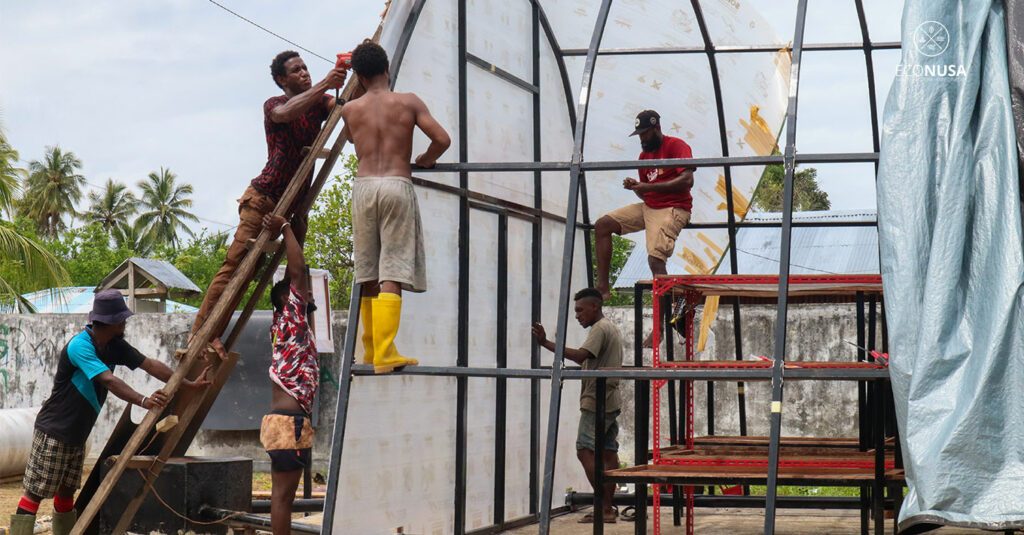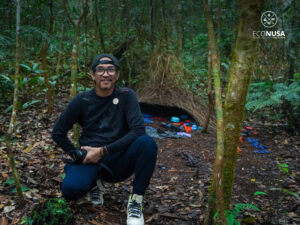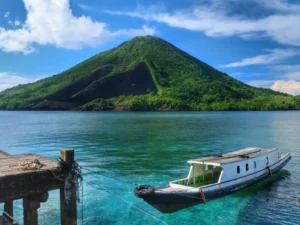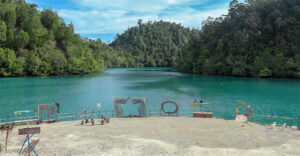
Independent management of local community livelihood resources is deemed one step to build community resilience in Tanah Papua. To achieve that goal, capacity building should keep going along with science development. Engagement of all stakeholders is expected to speed up the process here.
EcoNusa Foundation in collaboration with Perdikan/Insist Yogyakarta attempted to build community resilience in Kaimana Regency, West Papua, through School of Eco Involvement (SEI) program. The activities included Village Leader Workshop, Social Transformation School (STS). The workshop was attended by village leaders and Village Assembly Chief on 21-23 June 2021. Meanwhile, youngsters from 12 villages, namely Guriasa, Yarona, Edor, Kooy, Manggera, Egerwara, Warmenu, Kufuryai, Seraran, Mai Mai, Sisir II and Marsi Villages attended the STS from 25 June to 16 July 2021.
STS is divided into two classes, organic agriculture technology and multipurpose drying technology using solar energy and coconut shell charcoal as renewable energy. Local people who are accustomed to nomadic cultivation also got knowledge on soil fertility test, seeding management, seeding, pest and vegetation ailment control, liquid fertilizer and organic solid fertilizer production and bio pesticide production technique.
Read also: LJP Cooperative to Improve Community Economy
As to Alif Furu, a representative of Seraran Village, organic pest control was a new experience. Sunflowers commonly found in the village could be utilized as the pest control such as pest of trunk, fruit, leaf, seed, and root. Bright flowers produce nectar as the food of predators such as insects, dragonflies, bees, bugs, and spiders. When pests are on the vegetables, in addition to sunflowers, predators tend to eat vegetation pests.
“I have not so far got the knowledge on the use of materials surrounding us. When we lack seeds, we now can process them in our own villages,” said Alif.
Meanwhile, Milton Isoga from Kooy Village said that he got new knowledge on drying house construction. As to Milton, the construction here was far more difficult as it required accurate calculation of materials and welding.
Read also: Handing West Papua Forests Back to Titleholders
“Calculation (of drying house construction) is tough job. It is different from woodwork. Wood only needs nails. But drying house needs welding, measurement, bolts, and all is difficult,” he said. Milton will utilize the new drying house to improve quality of nutmeg and copra production which have thus far been dried in traditional way.
EcoNusa’s SEI Program Coordinator and Maluku Region Liaison Officer, Carmelita Mamonto, said that 12 villages were selected due to their close locations to forests. The ability for sustainable management of natural resources will serve as the crucial capital to cope with risks of losing livelihood sources lost due to forests clearance for plantation expansion or infrastructure development.
Without ability to identify and utilize the existing natural resources, the community tends to rely on external parties to meet their needs. Whereas, they actually have abundant natural resources. They are expectedly to become independent in livelihood with the given knowledge from SEI program.
Read also: Why Should Papuan Youth Study on Tanah Papua?
“If it is left uneducated, the community will be in high vulnerability due to the dependence on external parties. The existing livelihood and life resources are in the village. Most of their income spending is for food consumption. So, when they could provide their own food, it will cut off their domestic spending,” said Carmelita.
In addition to intensive assistance, social and spatial mapping of 12 villages is the recommended action following the workshop and STS. As to Carmelita, from mapping, the villagers could identify their own natural resources. From mapping, the community could plan various development of local potentials. “If there is social mapping, it could update for instance the number of families. From spatial mapping, the community could identify how large their forests are, who the owners, what purpose of vacant land is for,” added Carmelita.
Editor: Leo Wahyudi & Nur Alfiyah







